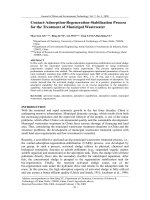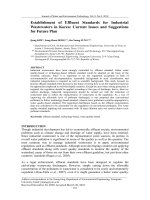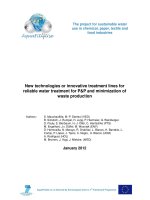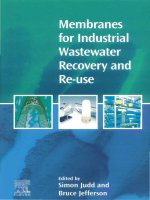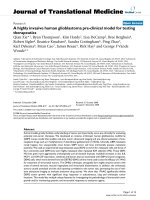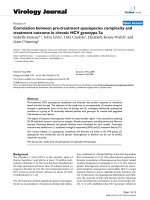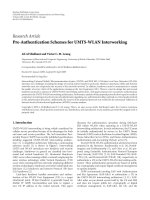Combined coagulation flocculation pre treatment unit for municipal wastewater
Bạn đang xem bản rút gọn của tài liệu. Xem và tải ngay bản đầy đủ của tài liệu tại đây (623.81 KB, 6 trang )
Journal of Advanced Research (2012) 3, 331–336
Cairo University
Journal of Advanced Research
ORIGINAL ARTICLE
Combined coagulation flocculation pre treatment unit
for municipal wastewater
Ibrahim M. Ismail a,*, Ahmed S. Fawzy a, Nabil M. Abdel-Monem a,
Mahmoud H. Mahmoud b, Mohamed A. El-Halwany b
a
b
Chemical Engineering Department, Cairo University, Giza, Egypt
Mathematical and Physics Department, Faculty of Engineering, Mansoura University, Egypt
Received 9 June 2011; revised 26 October 2011; accepted 28 October 2011
Available online 6 March 2012
KEYWORDS
Combined unit;
Coagulants;
Flocculation;
Hydraulic mixing;
Municipal waste water
Abstract The potentials of using the hydraulic technique in combined unit for municipal wastewater treatment were studied. A combined unit in which processes of coagulation, flocculation and
sedimentation, has been designed utilizing hydraulic mixing instead of mechanical mixing. A jar test
treatability study has been conducted to locate the optimum dose of the coagulants to be used.
Alum, ferrous sulfate, ferric sulfate, a mixture of ferric and ferrous sulfates, and mixture of lime
and ferrous sulfate were all tested. A pilot unit was constructed in the existing wastewater treatment
plant at El Mansoura governorate located in north Egypt. The optimum dose of coagulants used in
the combined unit gives removal efficiencies for COD, BOD, and total phosphorous as 65%, 55%,
and 83%, respectively.
ª 2011 Cairo University. Production and hosting by Elsevier B.V. All rights reserved.
Introduction
Since the first half of the 20th century, pollution in the Nation’s urban waterways resulted in frequent occurrences of
* Corresponding author. Tel.: +20 1000 401077; fax: +20 2
25266166.
E-mail address: (I.M. Ismail).
2090-1232 ª 2011 Cairo University. Production and hosting by
Elsevier B.V. All rights reserved.
Peer review under responsibility of Cairo University.
doi:10.1016/j.jare.2011.10.004
Production and hosting by Elsevier
low dissolved oxygen, which represents a hazardous impact
on the aquatic life. It kills fish, blooms algal and increases
the eutrophication and bacterial contamination [1]. Municipal
waste-water is a combination of different types of waste waters
originating from the sanitary system of commercial housing,
industrial facilities and institutions, in addition to any groundwater, surface water and storm water that may be present [2].
Untreated wastewater generally contains high levels of organic
material, numerous pathogenic microorganisms, heavy metals
as well as nutrients and toxic compounds. These waste waters
entail environmental and health hazards and, consequently,
must immediately be conveyed away from its generation
sources and treated appropriately before final disposal. The
ultimate goal of wastewater management is the protection of
the environment with public health and socio-economic
concerns [2]. Many different wastewater treatment technologies are used worldwide. Each one has its advantages and
332
disadvantages in terms of construction costs, operational costs,
energy consumption, operational complexity, effluent quality,
reliability, land requirements, and environmental impact. Recently some modern technologies were reported for waste
water treatment like up flow anaerobic sludge blanket (USAB)
[3–5], multi stage bubble column reactor [6] sequential batch
reactor (SBR) [7], fixed film anaerobic filter (AF) [8], expanded
granular sludge bed (EGSB), which is a modification to UASB
[9], up flow septic tank/baffled reactor (USBR) [10], submerged
membrane hybrid system [11], anaerobic-anoxic-aerobic bioreactor [12].
In more than 38% of the wastewater treatment plants in
Egypt, the levels of BOD and TSS in their effluents exceed
the 60 mg/l and 50 mg/l allowable limits for disposal into
drains, respectively. Usually 65–90% of the organic matter in
wastewater is colloidal or particulate matter, which can be reduced by chemical pre treatment of raw wastewater. Therefore,
chemically enhanced processes can be utilized to improve the
efficiency of primary treatment processes and to reduce the
cost of secondary treatment stage either by eliminating biological treatment, where it is possible, or by reducing the load of
secondary treatment units [13]. Generally, the chemical treatment process involves a series of three unit operations; rapid
mixing, flocculation and settling. At first, the chemicals are
added and completely dispersed throughout the wastewater
by rapid mixing. Coagulated particles are then brought
together via flocculation by mechanically inducing velocity
gradients. Finally, the solid materials are separated in clarification unit by gravity [14,15].
Two basic types of flocculation systems are able to induce
slow movement of the fluid; static hydraulic flocculators and
mechanical flocculators. In static flocculation systems, hydraulic mixers, slow mixing of the coagulant with water is achieved
by hydraulic means through sudden directional changes by
baffled channels, which could be either horizontal or vertical
[16]. This method is simple and free from moving parts, therefore it needs minimal operation and maintenance. It also exerts
minimal head loss across the flocculation tank. Disadvantages
of this type of flocculators include excessive velocity gradients
at the bends of the baffled channels and the dependence of the
velocity gradients on the flow rate within the basin; therefore,
they offer lower degree for control [17].
Usually it is feasible to use chemically enhanced treatment
for small and medium size plants. For small plants (less than
1000 m3 per day), chemically enhanced treatment only could
be feasible. For medium scale plants (less than 10,000 m3 per
day), combined enhanced primary treatment with reduced secondary treatment may be feasible. For larger plants, the combined unit is expected to be feasible only, if the discharge limits
are strict so that tertiary treatment may be necessary in case of
using conventional primary treatment.
The important factors that should be studied in pilot-scale
flocculation facilities are the appropriate chemical dose, the effect of mixing energy and the effect of mixing time, which are
achieved experimentally using the jar test [18,19]. Chemical
coagulants that are commonly used in wastewater treatment include alum (A12(SO4)3Æ18H2O), ferric chloride (FeCl3Æ6H2O),
ferric sulfate (Fe2(SO4)3), ferrous sulfate (FeSO4Æ7H2O) and
lime (Ca(OH)2). Recently some natural based materials like
chitosan and chitosan derivative were utilized in coagulation/
flocculation processes [20–22]. Synthetic organic polyelectrolyte’s are also sometimes used as flocculation aids [19,23–25].
I.M. Ismail et al.
The aim of this research is to conduct a jar test treatability
study to locate the optimum doses of the used coagulants and
to study the effect of different variables affecting the treatment
efficiency. Based on the results of the treatability study, a pilot
plant for the treatment of sewage combining rapid hydraulic
mixing coagulation, flocculation and settling in a single unit
is to be erected and utilized for the treatment of a real municipal wastewater. The final objective of this study is to find a reasonable method to treat sewage wastewater in a touristic
village far from governmental treatment stations.
Experimental
Materials
Raw sewage
The experimental study was carried out using raw sewage of
the El Mansoura governorate wastewater treatment plant,
Egypt. Due to the variation in the composition of wastewater
produced by Mansoura governorate, composite samples from
the effluent of the existing physical sedimentation tank were
collected using a continuous flow peristaltic dosing pump.
The samples were collected during 16.0 h daily. Characterization of the wastewater was carried out for almost 3 months
to cover the variations in the composition of the effluents as
they change by daily operation. Table 1 shows the average
characteristics of the wastewater used in this investigation.
Coagulants
The selected coagulants for the chemical treatment are alum
[Al2(SO4)3Æ18H2O], 99% purity, ferrous sulfate [Fe(SO4)Æ
7H2O], 97% purity, ferric sulfate [Fe2(SO4)3], 97% purity
and lime [Ca(OH)2], 99% purity. These coagulants are all of
technical grade. They have been used since they are produced
locally and available in the market with relatively low prices.
Methods
Jar test set-up
Jar tests were conducted in a set up with six stirred beakers of
2.0 l capacity. The beakers were filled with 1.5 l of wastewater.
The procedure of the jar tests and the values of different
parameters were obtained from literature with some tuning
[6,26] as follows:
The alum and ferrous sulfate solutions were prepared at
concentration of 1.0 g/l. Flash mixing is started at 350 rpm
and continued for one minutes during addition of coagulant
with dosage of 30, 60, 80, 100, and 120 mg/l. These dosage values were selected based on the value of suspended solids and
Table 1
Average characteristics of wastewater.
pH
Temp. (°C)
TDS (mg/l)
Turbidity [NTU]
COD (mg/l)
BOD (mg/l)
TSS (mg/l)
PO3À
4 ðmg=lÞ
NHþ
4 ðmg=lÞ
7.44
25
570
60
360
140
86
4
27.3
Combined coagulation flocculation pre treatment unit
333
50 cm
R1
10 cm
5 cm
20 cm
50 cm
Annulus
R2
25 cm
Sewage from presedimentation basin
resulting from the jar test treatability study, through a pipe line
connected to the suction line of the sewage centrifugal pump.
The rapid mixing of the sewage and the coagulant is carried
out by the centrifugal action in the feed pump. Slow mixing occurs in the annulus between the inner cylinder and the outer
body of the basin (the outer zone), where the flocculation takes
place. The inner zone is the space enclosed within the inner cylinder, where sedimentation occurs. The sludge settles into the
central hopper at the base of the treatment basin. Valves are
provided to redirect the settled sludge to the sludge holding
tank. The clarified effluent from the settling tank passes over
adjustable ‘‘V’’ notch weirs in the peripheral launder and then
an outlet pipe carries the treated effluent stream.
Analysis
The physical and chemical properties of the supernatant separated after flocculation and settling was analyzed according to
the well-known Standard Methods [1].
Treated Sewage
Sludge
Fig. 1
The compact treatment unit.
our previous experience. A flocculation process was conducted
for 30 min by gentle stirring, and then sedimentation for
30 min is carried out. The over flow samples have been drawn
and analyzed. The possibility to utilize a mixture of more than
one coagulant was also tested. The effect of the addition of different doses of lime to the optimum dose of ferrous sulfate,
60 mg/l, and different doses of ferrous sulfate to the optimum
dose of ferric sulfate, 60 mg/l, was also studied.
Pilot unit
The pilot unit consists of
1. A compact treatment unit, which is the core of the proposed system, is shown in Fig. 1. It consists of a cylindrical
tank provided with a conical bottom and inner vessel. Two
designs for the inner vessel were tested; cylindrical shape
and three conical shapes with three different cone angles.
The advantage of the conical shape is that the velocity gradient in the system was created due to the tapering of cross
sectional area in the path of water descending downward in
the annular space. This gives the chance for efficient flocculation. The main dimensions of the inner vessel designs are
given in Table 2.
2. Coagulant feed tank, 20 l capacity connected with a variable
speed dosing pump to control the dose of the coagulant.
3. Centrifugal sewage feed pump.
Methodology
The sewage water is pumped into the compact treatment basin
after the injection of the coagulants with the optimum dose,
Table 2
Results and discussion
Jar test treatability study
A jar test treatability study was carried out to select the optimum coagulants to be used in the pilot test and to determine
the optimum coagulant dosages. The use of coagulants such
as alum or ferrous sulfate is a common practice to coagulate
the suspended solids present in sewage wastewater, these coagulants are also cheap and safe and the produced sludge can be
easily handled. Four sets of experiments were carried out to
cover the corresponding variables and the used coagulants.
The effect of coagulants dosages on the removal efficiency of
Chemical Oxygen Demand (COD), Biological Oxygen Demand (BOD), Total Suspended Solids (TSS), and total phosphorous ðPO3À
4 Þ are illustrated in Fig. 2.
As indicated in Fig. 2, the removal efficiencies of COD,
BOD, TSS and PO3À
4 increase with the increase of alum dose
till they reaches the maximum value at about 60 mg/l. It is
worth noting that alum addition increased the particle size of
suspended material. This in turn enhances the settling of suspended matter due to coagulation. Consequently, this will affect the removal of some biodegradable organics belong to
the suspended solids, so the values of BOD and COD will decrease. Moreover alum addition will increase the possibility of
precipitation of insoluble phosphate, but the orthophosphate
remains as soluble material. No need to adjust pH in case of
using alum since the pH was around 6–6.5, which is the optimum condition. After the maximum dose value of 60 mg/l,
no appreciable improvement in the removal efficiency is observed by increasing the coagulant dose. The removal efficiencies of COD, BOD, TSS and PO3À
at the optimum dose of
4
Geometrical shape and dimensions of inner vessel.
Type
Upper radius, R1 (cm)
Lower radius, R2 (cm)
Height, H (cm)
Slope h (°)
Cylinder
Cone 1
Cone 2
Cone 3
20
22.5
20
17.5
20
12.5
12.5
12.5
50
50
50
50
90
75
80
85
334
I.M. Ismail et al.
90
(a)
80
%Removal
70
60
50
PO4 [ Ci = 4.5 mg / lit ]
40
TSS [ Ci = 86 mg / lit ]
30
COD [ Ci = 400 mg / lit ]
20
BOD [ Ci = 150 mg / lit ]
10
20
40
60
80
100
120
Alum Dose (mg/lit)
90
(b)
80
%Removal
70
60
50
40
PO4-3 [ Ci= 4 mg/lit ]
30
TSS [ Ci = 86 mg / lit ]
COD [Ci=320 mg / lit ]
20
BOD [ Ci = 140 mg / lit ]
10
20
40
60
80
100
120
Ferrous sulfate Dose (mg/lit)
90
(c)
80
Pilot unit
70
%Removal
the ferric sulfate dosage till it reaches the maximum at dosing
value of 60 mg/l. It can also be noticed that the value of the
removal efficiencies obtained using ferric sulfate is slightly
more than those values obtained using ferrous sulfate, which
is attributed to the greater charges of the ferric ions.
The addition of lime slightly improves the removal efficiency of the organic and suspended solids loads. The values
of the measured parameters of the treated effluent are lower
than the case of using ferrous sulfate alone as a coagulant. This
can be attributed to the higher pH of the solution after adding
lime. Increasing the dose of lime gives a slight increase in
COD, PO3À
4 removal. After a lime dose of 20 mg/l, no further
improvement in removal efficiency was observed. The use of
extra dosage of lime increases the alkalinity of the waste water
and may result in a final pH greater the recommended range 6–
9. In case of ferrous sulfate it was found that, by increasing the
dose of ferrous sulfate, the removal efficiency increased gradually till it reaches the maximum removal efficiency at dose
equal to 20 mg/l. After that no further improvement in the removal efficiency was observed by increasing the coagulant
dose. Table 3 shows a summary of all the jar test results.
Although the summarized results shown in Table 3 shows that
the highest removal was optioned upon using a mixture of ferrous and ferric sulfate, alum was selected for the pilot test as
the difference in separation efficiency between alum and the
mixture of ferrous and ferric sulfate was small and does not
justify the use of mixture of two materials, which will need extra mixing unit. Based on the results of the jar test study, the
use of 60 mg/l of alum was selected as the optimum coagulant.
The effect of retention time and geometrical shape of the inner
vessel on the removal efficiency of BOD, COD, TSS and total
phosphorous for treated stream flowing from the combined
treatment basin are discussed below using alum.
60
50
PO4 [ Ci = 4 mg / lit ]
40
TSS [ Ci = 86 mg / lit ]
30
COD [ Ci = 320 mg / lit ]
20
BOD [ Ci = 140 mg / lit ]
10
20
40
60
80
100
120
Ferric sulfate Dose (mg/lit)
Fig. 2 Effect of different coagulants dose on % pollutants removal. (a) Alum; (b) ferrous sulfate; (c) ferric sulfate. Flash mixing
time = 60 s, settling time = 30 min, flash mixing speed = 350 rpm,
pH = 6–6.5 and temperature = 30 °C.
alum were found to be 61, 53, 77 and 73 respectively. These removal efficiency values are slightly lower than the case of using
the more expensive polyelectrolyte [19,23–25]. Similarly, it is
also clear that increasing the dose of ferrous sulfate increased
the removal efficiency of pollutants gradually till it reaches its
maximum value at dose equal to 80 mg/l. Similar to the case of
alum, the using of ferrous sulfate will increase the particle size
of suspended materials, which enhances settling and coagulation of suspended materials. After maximum dose value no
appreciable improvement in the removal efficiency was observed by increasing the coagulant dose. The removal efficiencies of COD, TSS, BOD, and PO3À
4 are increased by increasing
Effect of retention time on wastewater characteristics
The effect of retention time on the percentage removal of TSS,
BOD, COD and Phosphorous for sewage was investigated and
displayed in Fig. 3. Results indicate that the optimum retention time is 150 min, which corresponds to a flow rate of
0.7 l/min. This retention time is lower than the retention time
of conventional chemical treatment unit, where it is usually
more than 3.5 h. After a retention time of 150 min, no further
improvement in the removal efficiency is observed by increasing the retention time. These observations may be explained by
the fact that at flow rates higher than 0.7 l/min., the residence
time is low and only a partial treatment for organic and suspended solids loads was obtained.
Effect of geometrical shape of the inner vessel on the percentage
removal efficiency of pollutants
The effect of geometrical shape of the inner vessel on the percentage removal efficiency of pollutants has been studied. The
different designs of the inner vessel were tested to check the effect of the velocity gradient in the system that was created due
to the tapering of cross sectional area in the path of water
descending downward in the annular space, on the efficiency
of the treatment process. The results of the study of the
Combined coagulation flocculation pre treatment unit
335
Summary of the results of the jar test study.*
Table 3
Coagulant
% Removal
Type
Dose (mg/l)
TSS
BOD
ðPO4 ÞÀ3
COD
Alum sulfate
Ferrous sulfate
Ferric sulfate
Ferric sulfate and ferrous sulfate
Ferrous sulfate and lime
60
80
60
60 + 20
80 + 20
77
74
77
86
78
53
48
48
50
50
73
69
70
76
73
61
56
59
61
60
Flash mixing time = 60 s, settling time = 30 min, flash mixing speed = 350 rpm, pH = 6–6.5 and temperature = 30 °C.
G¼
90
60
% Removal
ð1Þ
where x is the angular velocity (sÀ1) and Ri, Ro are the inner
and outer vessels radii Fig. 5 shows a schematic for the pilot
unit used with a cone as an inner vessel. The angular velocity
can be calculated from:
75
ð2Þ
x ¼ Vh =r
45
Tss [ Ci = 86 mg/lit]
30
COD [ Ci = 360 mg/lit]
BOD [ Ci =150 mg/lit]
15
PO4-3 [ Ci = 4 mg/lit]
0
30
60
90
120
150
180
210
Time (min)
Fig. 3 Effect of the compact unit retention time on % removal
of pollutant. Inner vessel = cylindrical and coagulant = alum
60 mg/l.
geometrical shape effect for the inner vessel on the removal
efficiency are illustrated in Fig. 4. It can be easily noticed that
using of cone (1) results in the best treatment of the sewage.
Results indicated that the removal efficiencies for TSS, COD,
BOD and total phosphorous are 83%, 65%, 55% and 76%,
respectively.
The average velocity gradient of the waste water, G, is a key
parameter in evaluating the performance of the coagulation
and flocculation processes. According to Leentvaar and Ywema [13], the maximum flocculation efficiency is obtained for a
G value in the range 10–25, which can be calculated according
to:
where Vh is the velocity of liquid tangent to the inner vessel
and r is the mean radius = (Ro + Ri)/2. Vh can be calculated
from the empirical formula [6]
Vh ¼ 3:98ðRo À Ri ÞÀ0:762 h0:379 Q0:121
80
70
ð3Þ
The average velocity gradient of the waste water, G, has been
calculated for each inner vessel case using Eq. ()()()(1)–(3) as a
function of the height h. Fig. 6 illustrates the relationship between G and h for the four internal vessels. It can be easily noticed that cone (1) has the highest G value up to 25. This
explains the experimental finding shown in Fig. 4 that cone
(1) has the best removal efficiency of BOD, COD, TSS and
PO4. It worth noting that at higher flow rates, the activated
sludge process may be more economic than the proposed
method. However, several problems arise using the activated
sludge because of the toxicity of bacteria and the adverse effect
on the biodegradation process.
The proposed combined unit will be mainly utilized for
touristic villages, which are not connected to any sewage systems, as they are distributed along the sea side. The discharge
of this system in such case will be used to irrigate the gardens.
In case of utilizing this system to treat municipal waste water,
where the effluent of this system will be fed to biological treatment unit, a by bass system could be used to adjust the COD
of the influent to the biological treatment unit.
Ro (outer radius)
% Removal (PO4)
% Removal (TSS)
% Removal (COD)
% Removal (BOD)
90
R1
V(θ)
60
Ri (inner radius)
50
Vz
40
Annulus
30
h
% Removal
2xRi R0
R2o À R2i
H
*
20
10
Vh
0
Cylindrical
Cone 1
Cone 2
Cone 3
R2
θ
Type of inner vessel
Fig. 4 Effect of the type of inner vessel on % removal of
pollutants. Coagulant = 60 mg/l and feed flow rate = 0.7 l/min.
Fig. 5
Schematic of the inner vessel shape and dimensions.
336
I.M. Ismail et al.
Velocity gradient G (Sec-1)
40
35
Cylindrical
Cone2
30
Cone 1
Cone3
25
20
15
10
5
0
0
10
20
30
40
50
Height (Cm)
Fig. 6
Variation of average velocity gradient (G) with height (h).
Conclusions
A jar test treatability study has been conducted to locate the
optimum dose of the coagulants to be used in the treatment
of the sewage from an existing wastewater treatment plant at
El Mansoura governorate located in north Egypt. Based on
the results of this jar test study, the use of 60 mg/l of alum
was selected as the optimum coagulant. A combined unit in
which process of coagulation, flocculation and sedimentation,
has been designed and operated utilizing hydraulic mixing.
Optimum retention time in pilot unit is equal to 2.5 h compared to 3.5 h for conventional chemical treatment. On using
alum in the pilot unit, it gives 83%, 65%, 55% and 76% removal efficiencies for TSS, COD, BOD and total phosphorous,
respectively. The proposed combined unit can be integrated
with existing sewage treatment plants to reduce the load on
the biological stage. It may be also used for the treatment of
sewage effluents of remote small villages and camps.
Acknowledgements
The authors would like to thank Dr. Hesham F. Aly from
the Egyptian Atomic Authority and Dr. Samia Sobhy from
Cairo University for their sincere support and informative
discussions.
References
[1] Clescerl Lenore S, Greenberg Arnold E, Eaton Andrew D.
APHA Standards methods for the examination of water and
wastewater. 20th ed. Washington DC: American Public Health
Association; 2001.
[2] Al-Sarawy A, El-Sherbiny F, Mels R. Coagulation and
flocculation of domestic sewage with organic polyelectrolyte.
Alex Eng J 2001;40(5):777–82.
[3] Tawfik A, Ohashi A, Harada H. Sewage treatment in a combined
up-flow anaerobic sludge blanket [USAB]-down-flow hanging
sponge [DHS] system. Biochem Eng J 2006;29:210–9.
[4] Axberg C, Wennerburg A, Stenius P. Flocculation of waste
emulsions using polyelectrolytes. Prog Water Technol 1980;12:
371–84.
[5] Camp TR. Floc volume concentration. J Am Water Works
Assoc 1973;60:656–73.
[6] El-Hallwany M. Chemical treatment of water, PhD thesis.
Minia (Egypt): Chemical Engineering Department, Minia
University; 2005.
[7] Environmental Protection Agency, EPA. Primer for municipal
wastewater treatment systems. Washington, DC: Office of
Wastewater Management; 2004.
[8] Renault F, Sancy B, Badot P, Crini G. Chitosan for
coagulation/flocculation processes – an eco friendly approach.
Eur Polym J 2009;45:1337–48.
[9] Heber G. Simple methods for the treatment of drinking
water. Deutschland: Gesellschaft fu¨r Technische Zusammenarbeit
(GTZ) GmbH; 1985.
[10] Yu J, Zhou S, Wang W. Combined treatment of domestic
wastewater with landfill leachate by using A2/O process. J
Hazard Mater 2010;178:81–8.
[11] Sahu J, Agarwal S, Meikap B, Biswas M. Performance of a
modified multi-stage bubble column reactor for lead(II) and
biological oxygen demand removal from wastewater using
activated rice husk. J Hazard Mater 2009;161:317–24.
[12] Kemira Kemi AB. Hand book on water treatment. Sweden: Helsingborg; 1990.
[13] Leentvaar J, Ywema J. Some dimension parameters of impeller
power in coagulation–flocculation processes. Water Res 1980;
14(2):135–40.
[14] Liu D, Liptak B. Wastewater treatment. Boca Raton, USA: CRC
Press; 1999.
[15] McConnachie G, Mtawali A, Young R. Design aspects of
hydraulic flocculators. In: Affordable water supply and
sanitation: proceedings of the 20th WEDC conference; August
22–26; Colombo, Sri Lanka; 1994.
[16] Tchobanoglous G, Burton F, Stensel H. Wastewater engineering
treatment and reuse. 4th ed. New York: McGraw-Hill; 2002.
[17] Halalsheh M, Sawajneh Z, Zu’bi M, Zeeman G, Lier J, Fayyad
M, et al. Treatment of strong domestic sewage in a 96 m3
UASB reactor operated at ambient temperature: two-stage
versus single stage reactor. Bioresour Technol 2005;96:
577–85.
[18] Switzembaum M. Anaerobic fixed film wastewater treatment.
Enzyme Microb Technol 1983;5:242–50.
[19] Katayon S, Noor M, Abdul Ghani L, Ahmad J. Influence of
cationic polyelectrolyte coagulant on microfiltration performance for treatment of oxidation pond effluent. Desalination
2005;184:423–30.
[20] Rebac S, Van Lier J, Janssen M, Dekers F, Swinkels K, Lattinga
G. High rate anaerobic treatment of malting wastewater in a
pilot-scale EGSB system under psychrophilic conditions. J
Chem Technol Biotechnol 1997;68:135–46.
[21] Sirianuntapiboon S, Sansak J. Treatability studies with granular
activated carbon [GAC] and sequencing batch reactor [SBR]
system for textile wastewater containing direct dyes. J Hazard
Mater 2008;159:404–11.
[23] Saitoh T, Asano K, Hiraide M. Removal of phenols in water using
chitosan-conjugated thermo-responsive polymers. J Hazard Mater
2011;185:1369–73.
[24] Sabry T. Evaluation of decentralized treatment of sewage
employing Upflow Septic Tank/Baffled Reactor [USBR] in
developing countries. J Hazard Mater 2010;174:500–5.
[25] Amuda O, Amoo I. Coagulation/flocculation process and sludge
conditioning in beverage industrial wastewater treatment. J
Hazard Mater 2007;141:778–83.
[26] Gonzalez T, Dominguez J, Beltran-Heredia J, Garcia H,
Snachez-Lavado F. Aluminum sulfate as coagulant for highly
polluted cork processing wastewater: evaluation of settleability
parameters and design of a clarifier–thickener unit. J Hazard
Mater 2007;148:6–14.
